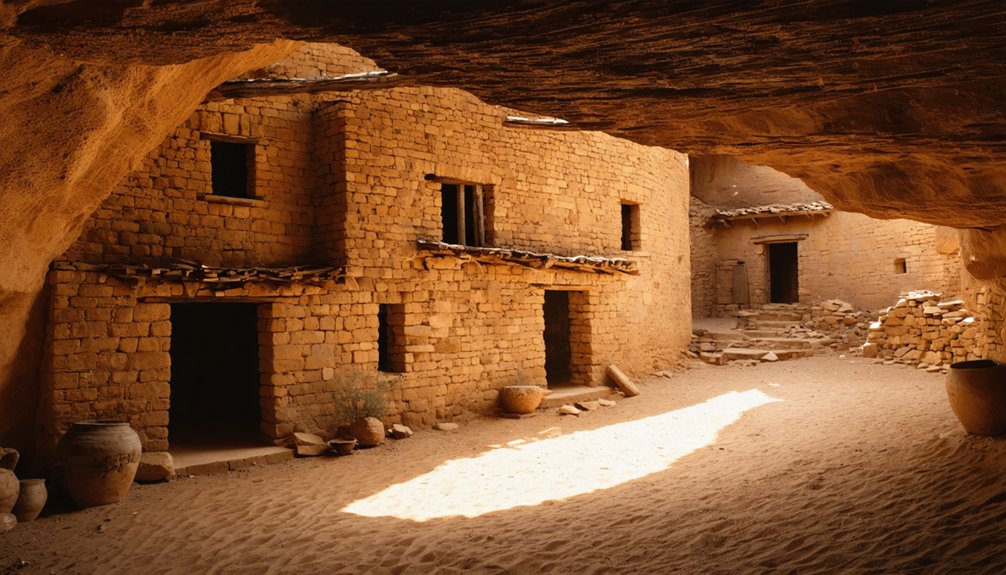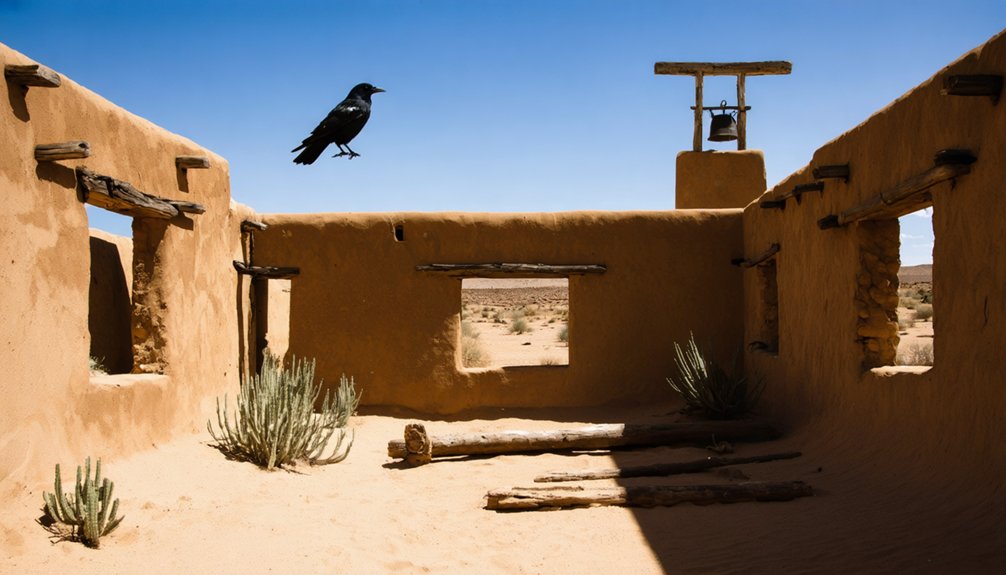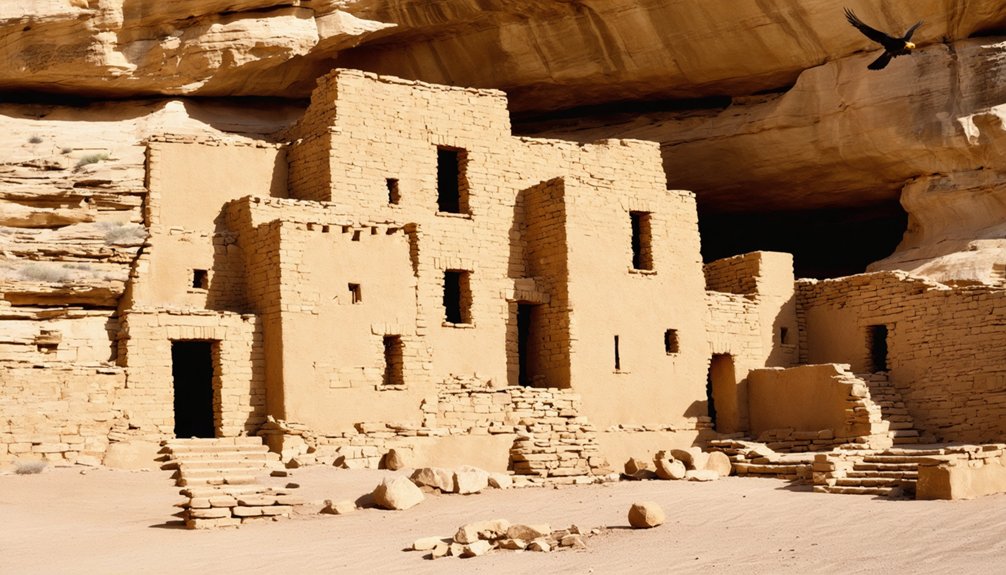You’ll discover remarkable abandoned Native American settlements across the US, from Mesa Verde’s cliff dwellings to Chaco Canyon’s astronomical great houses. These sites showcase Indigenous ingenuity through multi-story structures, celestial alignments, and sophisticated resource networks. Many settlements were abandoned due to drought, conflict, or colonial pressures, yet remain culturally significant. The stone walls and earthworks you’ll encounter tell stories of resilience that span thousands of years.
Key Takeaways
- Mesa Verde features over 600 cliff dwellings inhabited from 450-1300 CE, showcasing masterful stonework and adaptation to high altitude environments.
- Chaco Canyon’s Great Houses represent monumental architecture with precise astronomical alignments, abandoned around 1140 AD due to severe drought.
- Abandoned pueblos and missions of the Southwest reflect cultural collision between Indigenous communities and Spanish colonizers during the 17th century.
- Conservation challenges include tourism impacts, looting, vandalism, and climate-related threats to the structural integrity of ancient sites.
- Protection frameworks like ARPA and NAGPRA establish legal penalties for site disturbance while recognizing Indigenous authority over cultural heritage.
The Ancient Cliff Dwellings of Mesa Verde

Nestled within the dramatic sandstone cliffs of southwestern Colorado, Mesa Verde represents one of North America’s most remarkable archaeological treasures. Inhabited from 450 to 1300 CE, these settlements showcase sophisticated cliff dwelling architecture crafted from sandstone blocks and mud mortar.
You’ll find over 600 dwellings throughout the park, ranging from simple storage areas to Cliff Palace—an impressive complex with 150 rooms and 20+ kivas.
The ancestral puebloan lifestyle blended farming with spiritual practice, evidenced by agricultural terraces, reservoirs, and ceremonial chambers incorporated into one-to-four-story structures. Their masterful stonework ranks among the finest prehistoric masonry north of Mexico, demonstrating how these people adapted brilliantly to life at 2,600+ meters altitude. The site has suffered from conservation challenges due to tourism, extreme weather, and pollution that threaten the structural integrity of these ancient dwellings. Access to these extraordinary dwellings was originally achieved through retractable ladders that could be pulled up for protection.
Chaco Canyon: A Ceremonial Hub of the Ancient Southwest
When you explore Chaco Canyon‘s monumental “great houses,” you’ll encounter an architectural enigma that archaeologists still struggle to fully comprehend—structures containing hundreds of rooms that required millions of precisely cut sandstone blocks and massive timber beams transported from distant mountains.
The mysterious purpose of these elaborate complexes becomes clearer through their careful astronomical alignments, suggesting the Ancestral Puebloans possessed sophisticated knowledge of celestial movements.
You’ll find evidence of this astronomical expertise throughout the canyon, where buildings and petroglyphs mark solstices, equinoxes, and lunar cycles with remarkable precision. These structures, which include iconic sites like Pueblo Bonito with its 600+ rooms, were built during the Bonito phase when the community flourished between 800 to 1140 A.D. These impressive structures were eventually abandoned around 1140 AD when a severe drought beginning in 1130 led to chronic climatic instability that devastated agricultural production.
Great Houses Mystery
The Great Houses of Chaco Canyon stand as one of American archaeology’s most compelling enigmas, remarkable structures that challenge our understanding of pre-Columbian societies in the Southwest.
These architectural marvels weren’t merely residences but ceremonial centers and cultural hubs that integrated complex spatial planning with precise masonry techniques.
When you explore Chaco’s significance, you’ll discover:
- Multi-storied buildings with hundreds of rooms, constructed with deliberate planning rather than incremental growth
- Resource procurement networks that transported 240,000 trees from over 50 miles away
- Ceremonial spaces including kivas and plazas that facilitated gatherings for regional populations
- Sophisticated road systems connecting over 150 outlying Great Houses across the San Juan Basin
The T-shaped doorways and strategic sight lines demonstrate an advanced understanding of design that served both practical and ceremonial functions within this extensive cultural landscape.
The expert Chacoans masons utilized locally sourced sandstone to construct these impressive structures, which were eventually abandoned by the 14th century due to prolonged drought conditions.
Archaeological evidence reveals that these communities maintained extensive trade networks with Mesoamerican cultures, evidenced by discoveries of cacao, copper bells, and scarlet macaws.
Astronomical Knowledge Systems
Ancient Chacoan builders encoded their profound celestial understanding directly into the architecture and spatial organization of their settlements, creating one of North America’s most sophisticated pre-Columbian astronomical systems.
You’ll find twelve major structures aligned with solar and lunar cycles, capturing the 18.6-year lunar standstill pattern with remarkable precision.
The Sun Dagger phenomenon exemplifies their astronomical mastery—light beams perfectly bisect spiral petroglyphs during solstices and equinoxes, functioning as a ceremonial calendar. This knowledge supported both practical agriculture and lunar rituals.
The Chacoans integrated celestial alignments with natural topography, using cliff formations to frame astronomical events and constructing buildings on precise east-west axes. Modern Pueblo communities still regard these sites as sacred cosmographic expressions that connect to their ancestral heritage.
Even their road systems, particularly the Great North Road, reflect astronomical orientations that connect terrestrial space with their cosmic understanding. The North Road stands impressively 30 feet wide, demonstrating the engineering capabilities and ceremonial importance of these ancient pathways.
Abandoned Pueblos and Missions of the Southwest

Ruins scattered across the American Southwest tell a complex story of cultural collision, environmental hardship, and Indigenous resilience during the Spanish colonial period.
Weathered adobe walls bear witness to centuries of resistance, survival, and cultural endurance across Southwestern landscapes.
These abandoned pueblos and missions stand as a symbol of pueblo resilience despite Spanish colonization that brought forced labor, disease, and cultural suppression.
Mission architecture reveals the confluence of European designs with native materials and techniques.
The Salinas Pueblo Missions National Monument preserves the remnants of once-thriving Tompiro Pueblos that were abandoned in the late 1600s.
You’ll find evidence of this complex relationship in four key historical patterns:
- Widespread abandonment triggered by the 1680 Pueblo Revolt that temporarily expelled Spanish colonizers
- Environmental catastrophes including drought and famine that devastated communities
- Increasing Apache raids that undermined security after trade relationships collapsed
- Oppressive dual control systems where church and civil authorities competed for Indigenous compliance
The Mission San Xavier del Bac stands out among these historical sites as it has maintained continuous operation since 1859 after earlier periods of abandonment.
These ruins aren’t simply abandoned places—they’re monuments to Indigenous peoples who endured, resisted, and ultimately survived.
Poverty Point and Cahokia: Monumental Earthworks of Early Settlements
Long before European contact transformed North America, two remarkable Indigenous centers emerged through monumental earthworks that rival ancient architectural achievements worldwide.
At Poverty Point in Louisiana, hunter-gatherers built an astonishing complex of C-shaped ridges and mounds 3,400 years ago without agriculture or centralized leadership.
You’ll find evidence of a sophisticated society that moved 15 million baskets of earth—possibly within just three months—creating platforms that demonstrated communal power, not burial sites.
Cahokia, like Poverty Point, demonstrates how Native Americans organized massive construction projects through consensus rather than hierarchy.
Both sites featured extensive trade networks, with Poverty Point importing materials from up to 800 miles away.
Their abrupt abandonments—Poverty Point likely due to flooding—left these monumental earthworks as indicators of sophisticated engineering and communal organization that predated European settlement by millennia.
The Geographic Distribution of Native American Heritage Sites

Across the American landscape, five distinct geographic regions showcase the remarkable density of Native American heritage sites, creating a complex tapestry of Indigenous history that spans millennia.
You’ll find the Southwest holds the highest concentration, where Arizona and New Mexico feature ancient pueblos amid sandstone canyons.
Heritage mapping projects have meticulously documented these cultural landscapes through:
- GIS-integrated databases cataloging over 600 Indigenous place names in the Intermountain West
- Tribal consultations ensuring accurate representation of Native homelands
- Digital archives revealing historical trails, villages, and hunting grounds
- Specialized protections for sacred sites, many intentionally unmarked
The National Park Service now recognizes over 100 sites with direct Native American connections, while regional clusters in the Southeast, Great Plains, Pacific Northwest, and Alaska demonstrate the continent-wide extent of Indigenous presence.
Architecture and Cultural Features of Ancient Native Settlements
Ancient Native American settlement architecture reveals sophisticated adaptations to diverse environments, with structural systems evolving distinctly across tribal regions and time periods.
You’ll find earthfast post construction dominated Virginia’s Woodland settlements, with saplings set directly into ground perimeters forming circular dwellings between ten and thirty-three feet in diameter.
Settlement patterns shifted dramatically across cultures. Pueblo peoples progressed from underground pithouses to impressive multi-storied masonry structures, while Pacific Northwest tribes perfected post-and-beam systems using western red cedar with horizontal plank walls.
Building techniques varied considerably: Mississippians constructed elaborate earth mounds as platforms, while Prairie tribes created domed structures from saplings covered with bark and bison hides.
The Fort Christanna Indians selectively incorporated Euro-American rectangular designs while maintaining traditional elements—a reflection of cultural adaptation within established architectural frameworks.
Preservation Challenges and Collaborative Conservation Efforts

While sophisticated architectural adaptations helped Native American settlements flourish historically, these irreplaceable cultural treasures now face significant preservation challenges.
Modern threats include widespread looting—with thousands of sites vandalized annually—alongside institutional resistance to repatriation efforts.
Effective preservation strategies now emphasize collaborative stewardship through:
- Legal frameworks like ARPA and NAGPRA that establish criminal penalties for site disturbance and artifact trafficking
- Required tribal consultation processes that recognize indigenous authority over cultural heritage
- National Register listings that trigger federal protection mechanisms for significant sites
- Improved funding for enforcement and investigation of non-compliance
You’ll find these approaches represent a shift from historical practices that excluded Native perspectives.
Despite progress, enforcement remains underfunded compared to collection maintenance, highlighting persistent tensions between institutional control and indigenous rights to manage ancestral heritage.
Connecting Past and Present: Living Heritage of Native Sites
Despite the “abandoned” framing, you’ll discover many Native American sites maintain vibrant cultural continuity through communities like Taos Pueblo, inhabited continuously for over 1,000 years.
Tribal nations actively reclaim sacred spaces through collaborative management arrangements, such as the partnership between the Hoonah Indian Association and Glacier Bay National Park, enabling traditional practices to continue.
The preservation of oral traditions connects archaeological evidence with living knowledge, as demonstrated at centers like the Alaska Native Heritage Center, where over 200 tribes’ cultural practices are actively represented through performances and reconstructed dwellings.
Cultural Continuity Today
Throughout centuries of displacement and cultural disruption, Native American communities have maintained remarkable threads of continuity between ancestral settlements and contemporary life. Language revitalization programs and cultural programming in urban centers reconnect displaced populations to their heritage while traditional knowledge transfers through modern educational frameworks.
You’ll find this cultural persistence manifested through:
- Active tribal governance exercising treaty rights to manage ancestral lands
- Ceremonial structures and traditional arts that preserve intergenerational techniques
- Community-led workshops reviving traditional practices that strengthen social bonds
- Indigenous museums and cultural centers serving as knowledge repositories on tribal lands
This resilience reflects not merely survival but deliberate adaptation—integrating traditional ecological knowledge with contemporary land stewardship and creating economic opportunities through culturally significant artistry while addressing ongoing health disparities through culturally informed approaches.
Sacred Site Reclamation
The reclamation of sacred sites represents a powerful extension of cultural continuity efforts, transforming abstract heritage preservation into tangible land stewardship.
You’ll find tribes across America reclaiming ancestral lands through strategic collaboration with conservation groups and willing landowners.
The sacred site significance extends beyond physical property—these are places “where the Creator put us,” enabling essential ceremonies like the Wiyot Tribe’s World Renewal Ceremony on Tuluwat Island.
When you examine reclamation efforts, you’ll notice they’re grounded in legal frameworks like the 1868 Treaty of Fort Laramie, which mandates return of unused federal lands.
Despite development challenges, tribes persist through federal recognition processes, sometimes spanning decades, as with Oregon’s Confederated Tribes who regained 24 acres after losing their entire land base in 1956.
Oral Traditions Preserved
When ancestral settlements were abandoned, Native Americans preserved their cultural memory through oral traditions that connect contemporary tribal members to their historical sites and heritage.
These oral history initiatives now bridge ancient wisdom with modern technology, ensuring knowledge persists despite language loss.
Storytelling techniques maintain cultural continuity through four essential practices:
- Seasonal ceremonies where appointed speakers deliver historical narratives in both Native languages and English
- Community-based recording projects where youth interview elders using modern equipment
- Digital archives that capture not just words but intonations and non-verbal cultural cues
- University collaborations that have preserved approximately 1,000 Native American narratives through restoration and digitization
You’ll find these preservation efforts particularly meaningful when visiting historic sites, as they transform abandoned settlements into living landscapes of cultural memory.
Frequently Asked Questions
How Did Early Inhabitants Access Water in Cliff Dwellings?
You’d access water through natural springs within alcoves, collect rainfall, dig shallow groundwater wells, build check dams for cliff irrigation, and create stone-lined canals for efficient water sourcing in your settlement.
What Tools Were Used to Build These Complex Structures?
Like master sculptors of their destiny, you’d find these builders using grooved stone tools, celts, mauls, and hammerstones alongside binding techniques with plant fibers. Their earthworks techniques involved careful trench-digging for structural frameworks.
Did Different Native American Groups Trade With Each Other?
Yes, Native Americans traded extensively. You’ll find evidence of cultural exchange along vast trade routes that connected tribes across thousands of miles, facilitating movement of turquoise, shells, agricultural knowledge, and spiritual practices.
How Did Climate Change Affect Native Settlement Abandonment?
You’ll find that climate impacts drove settlement abandonment when drought, flooding, or extreme temperatures disrupted food systems. These environmental stressors fundamentally altered traditional settlement patterns across different ecological regions.
Are Tourists Allowed to Enter All Areas of Ancient Sites?
Definitely denied. You’ll face firm tourist regulations limiting access to many areas. Site preservation demands you honor access restrictions, protecting sacred and fragile spaces from damage. Tribal authorities control your permitted pathways.
References
- https://www.scmp.com/lifestyle/travel-leisure/article/3254037/ultimate-us-ghost-towns-exploring-ancient-native-americans-settlements-and-culture-and-camping-under
- https://www.nps.gov/articles/000/archeology-this-month-native-american-heritage.htm
- https://guides.loc.gov/native-american-spaces/cartographic-resources/indian-sites
- https://www.wilderness.org/articles/article/10-extraordinary-native-american-cultural-sites-protected-public-lands
- https://en.wikipedia.org/wiki/Native_Americans_in_the_United_States
- https://therestlessbeans.com/amazing-native-american-ruins/
- https://www.doi.gov/pressreleases/10-public-lands-powerful-native-american-connections
- https://viva.pressbooks.pub/arthistory/chapter/new-mexico-mesa-verde-ancient-puebloan-culture/
- https://smarthistory.org/mesa-verde-cliff-dwellings/
- http://hiddenarchitecture.net/mesa-verde/



